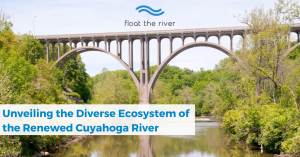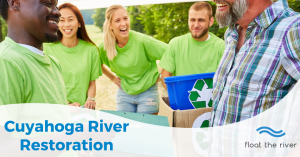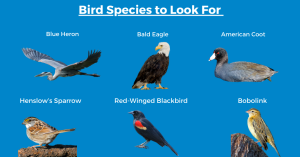Discover the Rich Biodiversity of the Restored Cuyahoga River

Today, the Cuyahoga River is an outdoor playground teeming with wildlife. Thousands of locals and tourists return annually to enjoy tubing and kayaking trips along the Cuyahoga. That wasn’t always the case, however. Once upon a time, the Cuyahoga was one of the most polluted waterways in the entire country.
Explore how the Cuyahoga went from being one of the “yuckiest” river ecosystems in the country to a thriving, beautiful waterway teeming with wildlife and plant species that you can experience with Float the River.
Table of Contents
- History of the Cuyahoga: the ‘River That Burned’
- The Cuyahoga River Comeback
- Biodiversity in Cuyahoga Valley National Park
- River Wildlife You Might See on a Cuyahoga Tubing or Kayak Trip
- Experience the Cuyahoga With Float The River
History of the Cuyahoga: the ‘River That Burned’
The Cuyahoga River was heavily polluted, dating back to the 19th century. Many cities along the river used to discharge their sewage into the water. Ohio’s industrial base used to dump pollutants in the river because it was the easiest way to “clean things up.” So many chemicals and oily discharges would build up on the river’s surface that it would take only a spark to catch the whole thing on fire. The first time that the river caught fire was in 1868. Historians think this has happened at least 14 times over the years.
The pollution in the Cuyahoga River eventually sparked the creation of the Environmental Protection Agency and the entire conservation movement in the United States. It took a long time for that to happen, however.
By the 1960s, Kent State University found that no surviving animal life remained in the river. There was almost no oxygen left in the water. The only plant life that could survive was a species of algae that grew on the surface near the piers. Oil slicks that were several inches thick floated on the surface. Visibility in the water was less than 6 inches.
The last time that the river caught fire was in 1969. “Time” magazine did a story on the “river that burned,” and it became a national issue. Many Americans wondered why we were not taking better care of our river ecosystems. The 1969 fire sparked the creation of the federal EPA, the Ohio EPA, and numerous conservation groups. Cleanup and rehabilitation efforts began not long after that.
The Cuyahoga River Comeback
Work to restore the Cuyahoga River watershed has been underway for decades now. Regulatory and legal changes now ensure that the river stays largely free from pollution, although it is still a “work in progress.”
The EPA has designated portions of the river and lands surrounding it as an area of concern, although that does not apply to the area where Float the River’s tours take place. Over the years, projects to rehabilitate the river have included replacing contaminated sediment, planting trees, removing dams, and installing natural stream features.
Today, when you visit the Cuyahoga on a Float the River tour, it’s easy to see how these efforts have paid off. The water is safe, and animal and plant life is abundant. Float the River continues to support conservation efforts to restore and improve the habitat each year. Cuyahoga River Restoration is an organization we proudly support. Along with our work to keep trash and litter picked up from the riverbed to keep the area as clean and pristine as possible through our yearly river clean up.

Biodiversity in Cuyahoga Valley National Park
The restoration of the Cuyahoga River has taught biologists and scientists a lot about the importance of biodiversity and how different species of animals within an ecosystem are all interdependent. It all starts with having the water clean and largely free of pollutants.
More than 40 species of fish live in the river, including steelhead trout and northern pike. These types of fish cannot survive in a polluted environment. The fact that they are once again abundant and thriving in the Cuyahoga is a testament to efforts to clean up the river. Because the water is cleaner, river insects, which provide food for fish and bats, are also returning.
The Conservancy for Cuyahoga Valley National Park is also trying to reintroduce freshwater mussels to the river. When mussel eggs are fertilized, they develop into a type of larva called glochidia. The glochidia attach themselves to the gills of a host fish as it passes by and live on the fish until they reach the juvenile stage. That’s when the glochidia will fall off the fish, dig down into the riverbed, and plant a whole new mussel bed.
Bird species like bald eagles and great blue herons are highly sensitive to water pollution. These birds migrated away from the Cuyahoga River for many years because no fish species could survive. Now that the fish are back, so are these magnificent birds. Great blue herons and other waterfowl can be spotted on the water, and bald eagles are once again nesting in the valley after avoiding it for many years.
Clean water is the baseline for all this biodiversity to exist along the river. Every animal and plant species depends on one or more other species to survive and thrive. Our family business relies on the water quality of the Cuyahoga River, which is why Float the River is dedicated to doing our part to keep it clean, safe, and thriving.
River Wildlife You Might See on a Cuyahoga Tubing or Kayak Trip
We offer tubing and short kayak trips on the Cuyahoga River every summer between Memorial Day and Labor Day. Float trips generally last 1–2 hours, depending on the depth and speed of the water. You can float from Cuyahoga Falls downriver, where you’ll have the opportunity to view many different types of river wildlife that now call the Cuyahoga home.
We can’t guarantee that you will see many of these species, but there’s always a chance! Float the River provides waterproof bags if you want to carry your camera or phone along for the float trip so you can snap a picture of any wildlife you spot.

As mentioned, bird species that frequent the area include great blue herons and bald eagles. Smaller bird species include red-winged blackbirds, bobolinks, Henslow’s sparrows, and American coots, among many others.
Beavers tend to stay in the ponds and streams that feed into the Cuyahoga River, but occasionally, one can be spotted on a float trip. Herds of deer that once avoided the water frequently stop by to drink.
Experience the Cuyahoga With Float the River
A river that once had no living animals is now a thriving ecosystem for hundreds of species of animals and even more insects and plants.
We started Float the River as an ecotourism company dedicated to improving the Cuyahoga River and the public’s perception of it. Indeed, this was once one of the most polluted waterways in America. Those days are long past, however, and now the river and Cuyahoga Valley National Park draw millions of visitors to the area each year.
Taking a tubing trip with Float the River is a relaxing activity for the entire family. Discounts are available for groups of 10 or more. Book now to get your beautiful day on the river scheduled before the season books up!
